New U.S. WWI Military Records for Genealogy
Topping the list of new and updated genealogy records this week are United States military records. Ancestry.com has a new collection of U.S. Navy Muster Rolls and an updated collection of historical postcards. Enjoy a special interview with military expert Michael Strauss on how he solved an old postcard mystery! Also new this week are WWI U.S. records at FamilySearch for Michigan and Utah, which you can access for free online.
Featured: U.S. Navy Muster Rolls
Ancestry.com has a new collection of U.S. Navy Muster Rolls, 1949-1963. From the description:
Historical Postcards
Ancestry.com also recently updated their collection of U.S. Historical Postcards, 1893-1960. You might be wondering how historical postcards would be valuable to your genealogy research. The collection description sheds some light on what you can use this database for:
“This database contains over 115,000 historical postcards with photos of places in the United States. Each postcard caption has been indexed and may be searched by keyword or location. The database also includes the city, county, state, and postcard era (estimated year range) for most postcards.
This database is primarily useful for obtaining a photograph or picture of a specific place in time. If you do not already have pictures of the places your ancestors lived, historical postcards are a good alternative to personal photos.”
In the video below: A captivating story unfolds of old postcards from WWI that are snatched from oblivion by Michael Strauss, who is the Genealogy Gems Podcast Military Minutes man. Michael shares the story of how he found the historic postcards on eBay, and the research process he followed to identify their author. These are strategies that you can use in many areas of your family history research!
FamilySearch
You can explore even more new WWI records for genealogy thanks to FamilySearch’s newest additions to their free records.
- Michigan, Census of World War I Veterans with Card Index, 1917-1919
- Utah, World War I County Draft Board Registers, Name Index, 1917-1918
- Utah, World War I Service Questionnaires, 1914-1918
These records may help you find out more about your ancestors who served in the military during WWI. Depending on the collection and record, you might find:
- name of Veteran;
- serial number;
- address;
- place and date of birth;
- nationality;
- color;
- occupation before and after the war;
- marriage date;
- wife’s name,
- birthplace and date;
- names of children and their birth dates;
- parents’ names and addresses;
- first camp entered and date;
- rank, company, and regiment;
- transfers and promotions;
- battles engaged in;
- discharged date and reason, and additional information.
If you don’t find the person you’re looking for, FamilySearch has these helpful suggestions for next steps:
- Look for variant spellings of the names. You should also look for alias names, nicknames and abbreviated names.
- Look for an index. Local genealogical and historical societies often have indexes to local records.
- Search the records of nearby localities (or military units, counties, parishes, etc.).
More Military Records with Michael Strauss
Michael Strauss is our resident Military Minutes man for The Genealogy Gems Podcast. He first debuted on the show on episode #207, where he talked about draft registrations. Click here to listen to the episode and download an exclusive free 4-page handout! For more expert military research tips and insight, browse Michael’s many articles on our website by clicking here.
About the Author: Lacey Cooke has been working with Genealogy Gems since the company’s inception in 2007. Now, as the full-time manager of Genealogy Gems, she creates the free weekly newsletter, writes blogs, coordinates live events, and collaborates on new product development. No stranger to working with dead people, Lacey holds a degree in Forensic Anthropology, and is passionate about criminal justice and investigative techniques. She is the proud dog mom of Renly the corgi.
Disclosure: This article contains affiliate links and Genealogy Gems will be compensated if you make a purchase after clicking on these links (at no additional cost to you). Thank you for supporting Genealogy Gems!
New & Updated US Genealogy Records Online
From coast to coast, U.S. records from the ‘genealogy giants’ are new and updated this week. Findmypast has a new collection of mine accident records for Pennsylvania (and we’ll also highlight a similar collection for England). Ancestry.com has updated a large number of genealogy collections for U.S. marriage, census, and military records that you’ll want to check out. And lastly, FamilySearch has made updates to a small set of U.S. county, tax, and enumeration records.
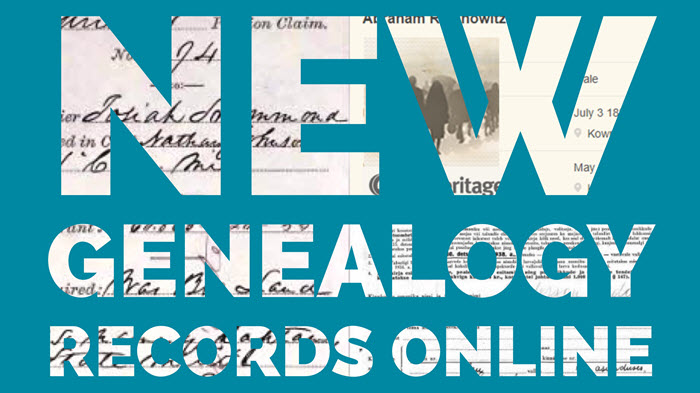
Pennsylvania, Register Of Mine Accidents
Mining was an integral part of United States history. Immigrants were able to find work in the mines but sometimes at great risk and peril. Findmypast has a new collection that may shed light on the miners in your family tree.
The Pennsylvania Register of Mine Accidents is a collection containing records from the Department of Mines and Mineral Industries. These records document mine accidents for the anthracite districts and the bituminous districts between 1899 and 1972. They are held by the Pennsylvania State Archives and links to the PDF versions of the accident registers are available on the transcripts.
Updated U.S. Records at Ancestry.com
Over at Ancestry.com you’ll find big updates to numerous records collections for the U.S.
Marriage Records
- Florida, County Marriage Records, 1823-1982
- Indiana, Marriages, 1810-2001
- Kentucky Mercer County Marriages (1786-1800) & Wills (1786-1801)
- Michigan, County Marriage Records, 1822-1940
- Michigan, Marriage Records, 1867-1952
- Montana, County Marriage Records, 1865-1993
- Oregon, County Marriage Records, 1851-1975
- Utah, Weber and Piute County Marriages, 1887-1940
Military Records
- Massachusetts Army & Navy, 1861-1865
- Missouri State Offices Political and Military Records, 1919 – 1920
- Official records of the Union and Confederate Armies, 1861-1865
- Kansas 353rd Infantry Regiment in World War I
- Connecticut State Register, 1924 Government & Military records
- U.S. WWII Draft Cards Young Men, 1940-1947
Census Records
- 1850 U.S. Federal Census – Slave Schedules
- Arizona and New Mexico Territories Census, Late 1800s
- Michigan, State Census, 1894
- Arkansas Census, 1840
More Updated US Genealogy Records at FamilySearch
Lastly, we head over to the all-free genealogy giant website FamilySearch. This week they’ve made updates to the following US genealogy records collections:
- Kansas, Gove County Enumeration Books and List of Residents, 1909-1950
- Montana, Sanders County Records, 1866-2010
- Ohio Tax Records, 1800-1850
- Texas, Cooke County, Deeds, 1895-1924
- Texas, Swisher County Records, 1879-2012
Most of these updates are pretty small, under 2,000 records. But you never know where your ancestor’s name might be lurking! The Ohio Tax Records collection has over 1.5 million new records, so if you have Ohio ancestors you’ll definitely want to check it out.
More U.S. Research Resources on the Free Genealogy Gems Podcast
If you’re filling in the gaps of your family tree with your U.S. ancestors, you’ll love episode #193 of the free Genealogy Gems Podcast! In this episode, we’ll talk about tips for using the U.S. Public Records Index. We’ll also dig deep into using the Freedom of Information Act (FOIA) for genealogy research, including what kind of records you can access, how to request them, and more. Take listen to this episode right now in the YouTube media player below, or find it on the go on the Genealogy Gems App!

Disclosure: This article contains affiliate links and Genealogy Gems will be compensated if you make a purchase after clicking on these links (at no additional cost to you). Thank you for supporting Genealogy Gems!
Genealogical Evidence and Proof: How to know if you’ve compiled enough evidence
The Genealogical Proof Standard tells us that we need to conduct reasonably exhaustive research in order for our work to be credible. If you’ve ever wondered just what constitutes “reasonable” (and if your family tree is up to snuff) my guest author Kate Eakman, professional genealogist at Legacy Tree Genealogists, has answers.

Professional Genealogist Kate Eakman explains evidence on the Genealogy Gems blog.
Genealogical Evidence: Have You Got What It Takes?
How do we know when we have compiled enough evidence to constitute proof?
Is a birth certificate or an autosomal DNA test result sufficient to declare this person is the child of that person?
Must we collect every record regarding an individual – the deeds, the tax lists, the newspaper clippings, the census reports – before we can declare a familial connection?
The Genealogical Proof Standard (GPS)
The Genealogy Proof Standard (GPS) directs us to perform reasonably exhaustive research, which requires that we identify and review all available records related to an individual.[1] This is being as thorough and accurate as possible and is a goal toward which we should all aspire in our genealogical research.
But, let’s be honest: most of us do not want to spend weeks or months (or even years) documenting one person before moving on to the next individual. We don’t want to know every detail of grandpa’s life before we turn to grandma.
We want to build a family tree which accurately provides us with the names of our ancestors so that we can identify our immigrant ancestor, or join a lineage society, or enjoy the satisfaction that comes from a balanced tree extending back a hundred years or more.
We want to be thorough and accurate, but we also want to make some progress. How do we balance the need for accuracy with the desire for results? How do we determine the necessary quality and quantity of evidence for our research?
Below are some guidelines to demonstrate how we can go about compiling the necessary information to say with confidence “this person is my ancestor.”
Genealogical Evidence Guidelines
1. One record/source is never enough.
Any one piece of data can say anything. A mother might lie on her child’s birth certificate for a number of reasons. A grieving spouse might not correctly recall the information for a husband or wife’s death certificate. There are typos and omissions and messy handwriting with which to contend. Even a lone DNA test is not sufficient evidence to prove a family connection.
We need multiple sources, and different kinds of sources, which corroborate the details of the others.

A single source is not enough. A marriage license does not guarantee that John and Griselda married. Photo courtesy https://newspapers.com.
A census report and autosomal DNA test results.
A deed and a will.
A birth certificate and an obituary.
Or, better still, a birth certificate, a census report, a deed, a will, an obituary, and autosomal DNA test results.
2. The more contemporary the source is to the person or event in question, the better.
Records of events made immediately after the event tend to be more accurate, and provide better details, than records created months or years later. As time passes, details become fuzzy, two events can be confused with each other, and our memories fade.
The passage of time between an event and the record of the event also allows for some revisionist history to creep in.
Here are some examples:
A birth year is adjusted to make someone appear older or younger in order to avoid the draft, enlist in the military, mask a dramatic age difference between spouses, or conceal an out-of-wedlock birth.
An obituary ignores the deceased’s first marriage because of some embarrassment associated with that marriage.
A census report enumerates everyone in the household as natives of Stepney, London, when they really were born in Stepney, and Hackney, and Whitechapel, which explains why the baptismal records can’t be found in Stepney.
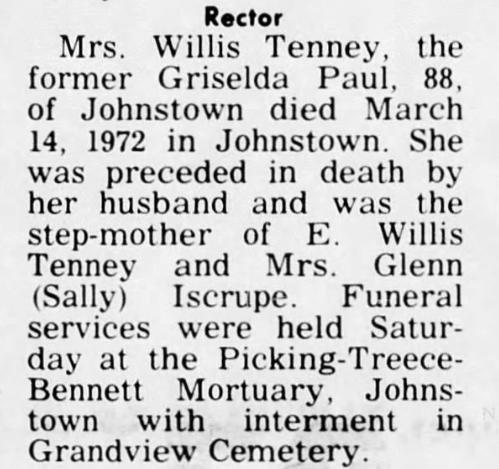
According to this obituary for Griselda, she was the widow of Willis Tenney, not John Wise. It appears Griselda and John did not marry after all. Photo courtesy https://newspapers.com.
According to this obituary for Griselda, she was the widow of Willis Tenney, not John Wise. It appears Griselda and John did not marry after all. Photo courtesy https://newspapers.com.
This is particularly true when it comes to autosomal DNA testing. My autosomal DNA is more useful for identifying my ancestors than is my son’s because I am one generation closer to those ancestors. This is the reason we encourage people to test the oldest members of their family first: their DNA has the potential to be the most useful simply because they are from an earlier generation (or two).
3. It is okay to make appropriate assumptions, but be careful!
In genealogical research we must sometimes make assumptions. When research theories are based on logical reasoning, it is perfectly acceptable to make those appropriate suppositions.
Determining which assumptions are appropriate can be simple: the two-year-old child enumerated in the home of a 90-year-old woman in the 1850 census can safely be eliminated as a biological child of that woman; the man born in 1745 could not have been buried in 1739; the person with whom I share 3150 cM of DNA is my sibling.
The challenge is to avoid making what seems like an appropriate assumption but is really based on faulty reasoning or bias. For instance, we presume that every child listed in a household in the 1860 U.S. Census is son or daughter of the two adults listed first. However, the household could include step-children, cousins, or individuals not even related to the family who were erroneously assigned the same surname.
Other inappropriate assumptions can include:
- the notion that a baby was born within a week of his baptismal date;
- a woman’s reported surname on her marriage certificate is her maiden name;
- there is only one person in any village, town, or city with the name of your ancestor;
- someone who shares 2000 cM of DNA with you must be your grandparent, aunt or uncle, niece or nephew, half sibling, or grandchild (they could be a ¾ sibling, the child of one of your parents and the sibling of the other parent).
4. All of the data from the various sources must correlate, and there can be no unresolved contradictions.
When the birth certificate says Richard was born in 1914, the 1938 newspaper article about his wedding reports Richard was 24 years old and the 1942 World War II Draft Registration card notes Richard’s date of birth occurred in 1914, we can confidently declare Richard was born in 1914.
If the wedding article declared the groom was 23 years old the contradiction could be explained by the time of year in which the wedding occurred – before or after Richard’s birthday.
But if his birth certificate reported a 1914 birth, and the newspaper article noted Richard was 32 years old, while the World War II Draft Registration listed his year of birth as 1920, we have some important contradictions. It is most likely the records are for three different men with the same name.
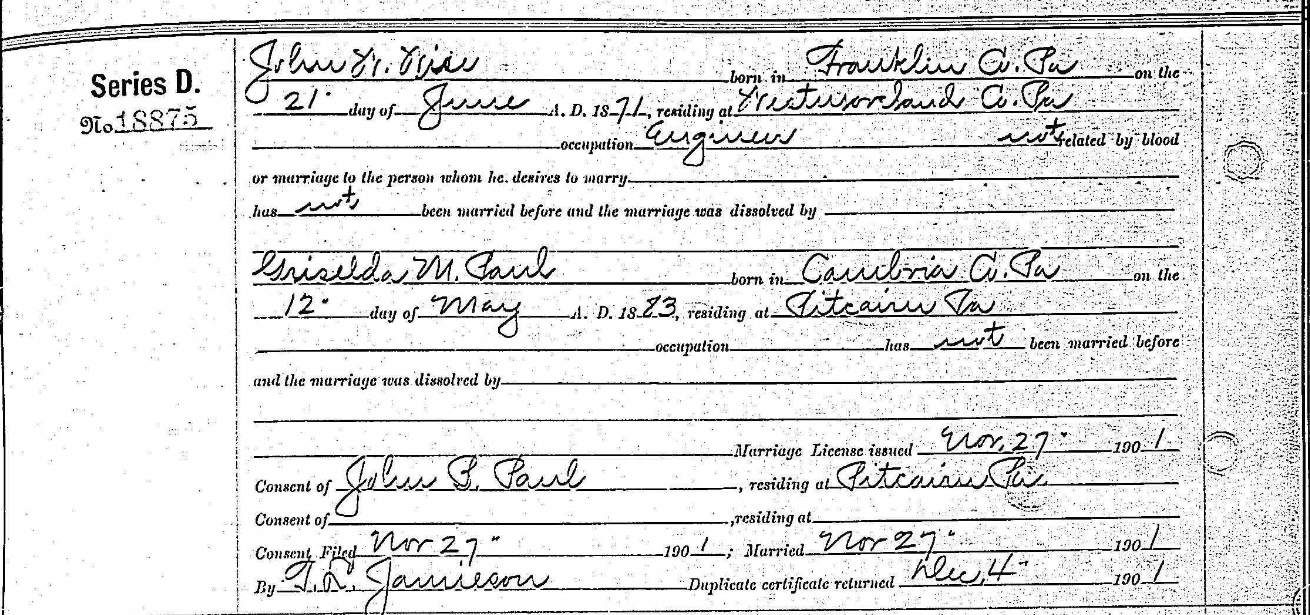
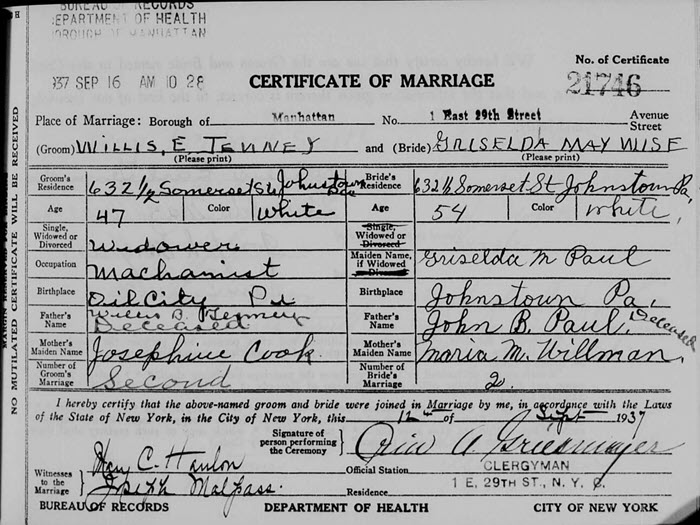
By collecting additional evidence, we finally learn that Griselda and John Wise did marry, and after his death Griselda married Willis Tenney. If we had collected only one of these four records we would not have had the most accurate information regarding Griselda Paul. Photos courtesy https://familysearch.org.
It’s important to remember that once we have accomplished that initial goal of building out our tree a few generations (or identifying our immigrant ancestor, or determining if we are related to that historical person) we can – and should – go back and collect other sources related to that person. This will result in uncovering a more complete story of their lives in the process.
As we can see from the four documents regarding Griselda Paul’s marriages, her story is much more than a simple list of birth, marriage, and death dates. As we identify, review, and analyze the other available sources, Griselda’s story will come alive with the facts and details we uncover.
A Fresh Set of Eyes on Your Genealogy Brick Wall
Sometimes the wrong evidence or assumptions can push us into a brick wall. A fresh set of expert eyes can help you identify the problem, and recommend the sources you need to pursue in order to compile trustworthy evidence.
If you are looking for some assistance in your genealogical research, Legacy Tree Genealogists can help. Our affordable ($100 USD) Genealogist-on-DemandTM Virtual Consultation service provides you with the opportunity for a 45 minute one-on-one discussion of your research with one of our expert genealogists. We can help guide you in evaluating evidence and determining research strategies to move forward with your research confidently.
About the Author: Kate Eckman
Legacy Tree guest blogger Kate Eakman grew up hearing Civil War stories at her father’s knee and fell in love with history and genealogy at an early age. With a master’s degree in history and over 20 years experience as a genealogist, Kate has worked her magic on hundreds of family trees and narratives.
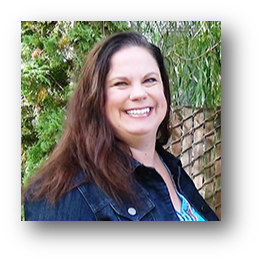
Professional Genealogists Kate Eakman
[1] “Genealogical Proof Standard (GPS),” Board for Certification of Genealogists, https://bcgcertification.org/ethics-standards, accessed March 2020.

